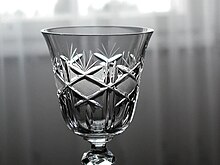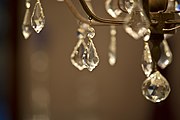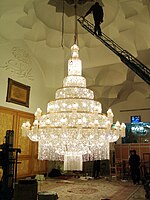Cut glass


Cut glass or cut-glass is a technique and a style of decorating glass. For some time the style has often been produced by other techniques such as the use of
Today, the glass is often mostly or entirely shaped in the initial process by using a mould (
There are two main types of object made using cut glass: firstly drinking glasses and their accompanying decanters and jugs, and secondly chandeliers and other light fittings. Both began to be made using the cut glass style in England around 1730, following the development there of a reliable process for making very clear lead glass with a high refractive index.[2] Cut glass requires relatively thick glass, as the cutting removes much of the depth, and earlier clear glass would mostly have appeared rather cloudy if made thick enough to cut. For both types of object, some pieces are still made in traditional styles, broadly similar to those of the 18th century, but other glassmakers have applied modern design styles.
Expensive drinking glasses had previously mostly concentrated on elegant shapes of extreme thinness. If there was decoration it was mostly either internal, with hollow bubble or coloured spirals within the stem ("twists"), and spread the light in way that was new, and were enthusiastically embraced by makers and their customers. The main skeleton of the chandelier was very often metal, but this was often all but hidden by a profusion of faceted glass pieces, held in place by metal wire.
Technique

In the first century AD,
Typically the design is marked with paint on the glass before cutting – in England red is usually used.[9] One advantage of cut glass for the manufacturer is that it can very often be arranged for the small flaws such as bubbles that are inevitable in a proportion of glass pieces, and would lead to a clear piece being rejected, to be placed in the areas to be cut away.[10] Conversely, if imitation cut glass using moulds is made, the complexity of the mould shapes greatly increases the number of faults and rejects.[11]
A second operation polishes the cut glass, traditionally using a wooden or cork wheel "fed with putty powder and water".[12] In the late 19th century, an alternative method using fluoric acid was introduced; this made the process of polishing faster and cheaper.[13] However, it "gives a dull finish and tends to round off the edges of the cuts".[14]
Labour was the main cost in making cut glass. Arguing against the reduction of tariffs in 1888, a leading figure in the American industry claimed that "We take a piece of glass .... costing 20 cents and .... in many cases put $36 of labor on it".[15]
History

Technically, the decorative "cutting" of glass is very ancient, although the term "cut glass" generally refers to pieces from the 18th century onwards. The
Very shallowly scratched or cut
In the later 17th century George Ravenscroft developed a cheap and reliable lead "crystal" glass with a high refractive index in England, which various other glassmakers adopted. After some time, the potential of cut glass using this basic material began to be realized;[22] a high lead content also made the glass easier to cut.[23]
Chandeliers
In the early 18th century, bevelled edges to large mirrors became fashionable in England, achieved by rubbing with abrasives, but also by "cutting". The making of "looking glasses" was a different branch of glassmaking from the makers of drinking glasses, and it seems to have been in the former that "the craft of cutting was born", and the mirror makers were the workshops who expanded into chandeliers.[24]
A London glassmaker advertised in 1727 that he sold "Looking Glasses, Coach Glasses and Glass Schandeliers".
Over the rest of the 18th century, and the early part of the next the number of drops increased, and the main stem of the chandelier, typically in metal, tended to disappear behind long chains of them. By the
By 1800 it was already common to dismantle chandeliers and reconfigure them into a more fashionable shape, and subsequently most old chandeliers have been converted from candles to electricity, often after a period as
-
Oddly-sited Victorian chandelier
-
Detail of cut glass "drops" or pendants
-
Large modern chandelier being worked on, Iran.
Vessels

Starting out by decorating mainly wine glasses, decanters and other
On wine glasses and similar shapes, the rim where the drinker's mouth would touch was left smooth, but the bowl, especially the lower part, the stem, and the foot might be cut. A starburst on the underside of the foot was common. On jugs, cups for eating desserts from, and bowls the rim was often cut with zig-zags or other ornament.
Competition from cheaper, but lower quality
-
Dessert glass, England, 1760–80
-
Bowl, 1820–30, English
-
Irish jug, early 19th century
-
English (?) vase, c. 1835
1850 onwards

The centrepiece at the crossing of the Crystal Palace holding the Great Exhibition of 1851 in London was a huge glass fountain (8.25 metres or 27 feet high), including much cut glass, by the leading Birmingham firm of F. & C. Ostler.[40] Cut glass had dominated both its main market niches for several decades, but a number of factors were about to challenge it, at least as far as vessels were concerned. The Victorian taste for over-ornamentation was beginning to take over, and some of the cut glass displayed at the Great Exhibition was described as "prickly monstrosities".[41] In the year of the exhibition, the hugely influential critic John Ruskin, in his Modern Painters, denounced the whole technique, writing "We ought to be ashamed of it" and "all cut glass is barbarous, for the cutting conceals its ductility and confuses it with [rock] crystal".[42]
At the same time, and further stimulated by the Great Exhibition itself, the British style was spreading across the Western world, and in particular cut American and
In the 1870s the "brilliant", "brilliant cut" or "American Brilliant" style emerged, perhaps first seen in America in glass exhibited at the 1876
Decline

The last decades of the 19th century saw exciting new developments in glass design, with much use of colour, the Victorian version of

At the end of the century the market for expensive decorative glass appears to have slumped, perhaps because so much was now being made and traded internationally.[47] Corning's cut glass industry peaked in 1905, when a directory recorded 490 cutters there, and 33 engravers, though the quality of some work was falling; by 1909 the number of cutters had fallen to 340.[48]
The arrival of
But some glassmakers, for example in Art Deco, were sympathetic to linear and geometric decoration and made use of the technique, often as one of a number of techniques used in a single piece. This continues to be the case in the recent studio glass movement. In mid-20th-century England there was a revival in engraved glass, which was often accompanied by some cutting; the work of Keith Murray includes examples.[51] Traditional cut glass designs are still used, for example in what Americans call the Old fashioned glass, a whisky or cocktail tumbler. In chandeliers, however, the clear cut glass style has been adapted successfully to modern styles and still holds its own, especially for large public spaces such as hotel lobbies.[52]
Cut-glass accent
In
Notes
- OED, from 1845. But Ruskin used "cut glass".
- ^ Osborne, 403
- ^ Osborne, 403
- ^ Osborne, 153
- ^ Osborne, 398–399, 403
- ^ Powell, 3
- ^ Powell, 140–141; Battie & Cottle, 110
- ^ Battie & Cottle, 102
- ^ Farr, 107
- ^ Farr, 108–109
- ^ Farr, 113
- ^ Powell, 141; Battie & Cottle, 191
- ^ History
- ^ Sinclaire, 19–20; Battie & Cottle, 191 (quoted); Farr, 107
- ^ Sinclaire, 11
- ^ Battie & Cottle, 102
- ^ Battie & Cottle, 35
- ^ Battie & Cottle, 40–43; Osborne, 670
- ^ Battie & Cottle, 44
- ^ Osborne, 395–397, 690
- ^ Battie & Cottle, 84
- ^ Battie & Cottle, 94; Osborne, 403; Davison and Newton, 40
- ^ Sinclaire, 8
- ^ Battie & Cottle, 102
- ^ Davison and Newton, 69–70; History
- ^ Davison and Newton, 69–70; History
- ^ History; Davison and Newton, 71; History
- ^ Battie & Cottle, 103
- ^ Battie & Cottle, 103–104
- ^ Davison and Newton, 68–69
- ^ Battie & Cottle, 110–111 (110 quoted); Osborne, 403
- ^ Battie & Cottle, 127
- ^ Battie & Cottle, 128
- ^ Osborne, 403
- ^ Battie & Cottle, 110
- ^ Battie & Cottle, 128
- OED, "Cut", as past participle, 3, the oldest usage the original OED could find.
- ^ Battie & Cottle, 110
- ^ Sinclaire, 2–6
- ^ Battie & Cottle, 111; Davison and Newton, 71
- ^ An often quoted but rarely attributed description. It certainly appears (without quotation marks) in European Glass: A Brief Outline of the History of Glass, 1926, by Wilfred Buckley and Ferrand Whaley Hudig
- Apollo Magazine, accessed 10 May. 2021, online
- ^ Battie & Cottle, 112–120; Osborne, 403–404
- ^ Battie & Cottle, 1188 (quoted); Osborne, 409: Sinclaire, 13–14. A "strawberry diamond" is a set (usually four) squares inside a diamond, the squares with further ornament inside, example.
- ^ Battie & Cottle, 120–123, 128–135
- ^ Battie & Cottle, 143–161; Sparke, 31–33; "Wine Glass (England), ca. 1900", Cooper Hewitt, Smithsonian Design Museum; Farr, 108–110
- ^ Battie & Cottle, 128
- ^ Sinclaire, 7, 17
- ^ Powell, 138
- ^ Powell, 139–140
- ^ Sparkes, 33–37; Battie & Cottle, 170
- ^ History
- ^ "cut glass", The Cambridge Advanced Learner's Dictionary & Thesaurus, Cambridge University Press
- ^ Robson, David, "Has the Queen become frightfully common?", BBC website, 3 February 2016
References
- ISBN 1850296545
- Davison, Sandra and Newton, R.G., Conservation and Restoration of Glass, 2008, Taylor & Francis,
- Farr, Michael, Design in British Industry: A Mid-century Survey, 1955, Cambridge University Press, google books
- "History": "A History of the Chandelier"
- Osborne, Harold (ed), The Oxford Companion to the Decorative Arts, 1975, OUP, ISBN 0198661134
- Powell, Harry J., Glass-making in England, 1923, Cambridge University Press, google books
- Sinclaire, Estelle F., Complete Cut and Engraved Glass of Corning (New York State Series), 1997, Syracuse University Press, google books
- Sparke, Penny, "At the Margins of Modernism: The Cut – Crystal Object in the Twentieth Century", 1995, Bulletin of the John Rylands University Library of Manchester, 1995 , 77 ( 1 ) : 31–38, PDF
Further reading
- Fisher, Graham, Jewels on the Cut: An Exploration of the Stourbridge Canal and the Local Glass Industry, 2010, Sparrow Books
- Spillman, Jane Shadel, The American Cut Glass Industry: T.G.Hawkes and His Competitors, 1999, ACC Art Books
- Swan, Martha Louise, American Cut and Engraved Glass of the Brilliant Period in Historical Perspective, 1986, Gazelle Book Services
- Warren, Phelps, Irish Glass: Waterford, Cork, Belfast in the Age of Exuberance (Faber monographs on glass), 1981, Faber & Faber







